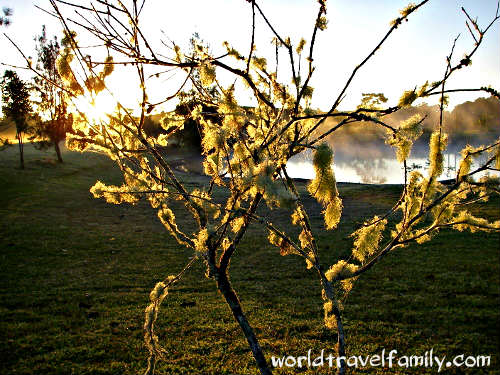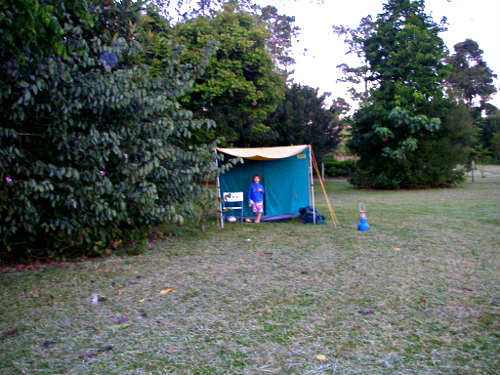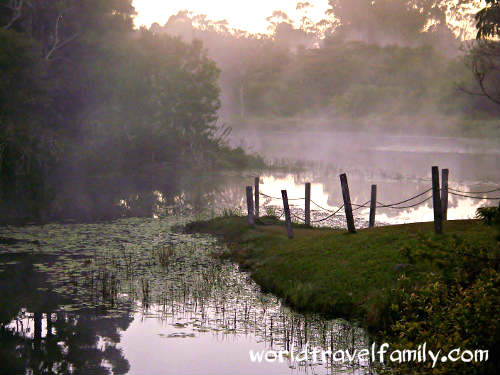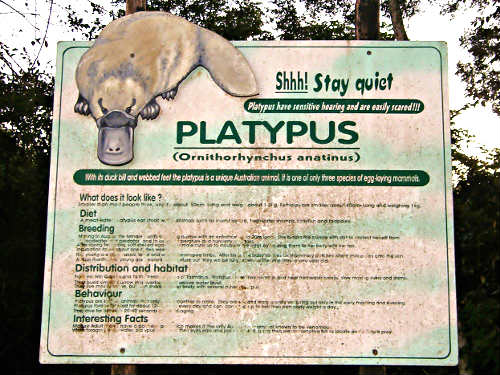
We saw an Australian animal that less than 10% of all Australians have ever see on our last camping trip. The fantastic, and surprisingly tiny, platypus.
Now we’ve taken the decision to leave our tropical paradise I’m determined to make the most of our current location. With this in mind we’ve just had 2 nights camping up the mountain behind us, on the Atherton Tablelands, so many experiences packed into less than 3 days! We had a blast.

It was cold!!!
We live down on the coast in Port Douglas, its hot all year round and from December to May it’s seriously wet and humid. If we drive just a little way up the road we can climb up to the top of the mountain and be in a completely different climate. It was cold! OK, so it’s mid winter, but I wouldn’t expect night-time temperatures to dip to freezing in the tropics, would you? On the coast here we’re shocked if it gets below 20 degrees, but zero, in a tent, crazy! For most of the year the climate up on the tablelands is significantly more comfortable than on the coast, it makes a great place to take a break from the heat.
It is very easy to get up onto the tablelands from Cairns or Port Douglas by car.

Dawn at the platypus pond
We’ve done so much I can’t squeeze it into one blog, camping at Tarzali Lakes, deserves a blog of its own. We picked the site because it’s fairly cheap at $25/ night , we didn’t realize we’d actually be “Glamping”.
The Tarzali Lakes Aquaculture Centre is a series of lakes, some natural, some man-made, a yabbi breeding farm, a barramundi farm and fishery, a smokery and restaurant and one of the rare places where you can see platypuses in the wild.

We were the only people camping there, so after 4pm when the day tourists had gone and the owner had gone off to the pub, we were left to free range all over the site and use the outdoor restaurant facilities for eating and cooking. There were even some fairy lights left on for us. This was the glamping part, lots of tables and chairs, a gas barbecue and our own private bathroom. It makes such a big difference when you are living in a tent. We still had our camp fire too, the kids feel cheated if they don’t get to build a fire and toast marshmallows. So there we were, in a beautiful spot, all alone, with excellent facilities and nature all around us. Perfect!
The main attraction is obviously the platypuses so we crept down to the pond at the bottom of the hill, shushing and tiptoeing, wondering if we’d be lucky enough to see one.
We did, straight away, and then another, and another. There were plenty, all very active and busy feeding. They popped up for air now and again and stayed on the surface for a little while before duck diving back down. Both kids pronounced them cute and loved the whole experience. D in particular was happy to just sit a watch them, animals have a magical calming effect on him. We had some special times together hanging by that pond and singing Yellow Submarine to our weird little friends.
I’m having an ongoing battle with Nikon over a faulty camera, so unfortunately, all photos are on my husband’s phone, no zoom to get a decent platy-pic, which was a shame, but I did my best.
Obviously, as homeschoolers, this was a great opportunity for Mum to slip a bit more learnin’ by the boys. They ask questions constantly, it’s part of being a child, they already knew that platypuses and echidnas are monotremes, egg laying mammals. We had a little chat about milk production, this being the defining feature of mammals, they were a bit confused initially by the egg/ milk combination. It is weird after all! We talked about their sensitive beaks and how they use touch and an extra sense, electrolocation, to find their prey, small invertebrates and vertebrates. We talked about how they stayed warm and why they were so rarely seen, it’s believed less than 10% of Australians have ever seen a platypus, although they are not classed as endangered. I mentioned that they are the only venomous mammals. They quickly shut me up.
” We know Mum, we saw it on Deadly 60.”
I love Steve Backshall on so many levels!
They asked if any predators fed on platypuses, they do, eagles, snakes, crocodiles and goannas aren’t their friends. They are considered a nocturnal animal although the individuals we saw were extremely active by day. So this is how learning happens in our family, the world is our classroom and it’s rather nice.
Today, back home, and enjoying the delicious smoked goods the owner kindly gave us at Tarzali (another perk of being a Chef’s Widow) I will try to get D to use the internet to find out more about these amazing little creatures. Making it fun and building on the interest that has been planted in him by our encounter is a sure-fire way to get that learning cemented.
The next morning, after a cold night snuggled under my best feather duvet, we were up with the roosters to see the most amazing sunrise over a misty lake. This was a golden opportunity for me to talk, yet again about evaporation, condensation, the water cycle and so on.
As I boiled the water for coffee at the lakeside Boo said ” Look Mum, platypus!” He was right, they were here in the main barramundi breeding lake too. Only a child that had spent the previous evening platypus watching would have recognised the distinctive profile of a one of these brilliant little creatures at the surface.